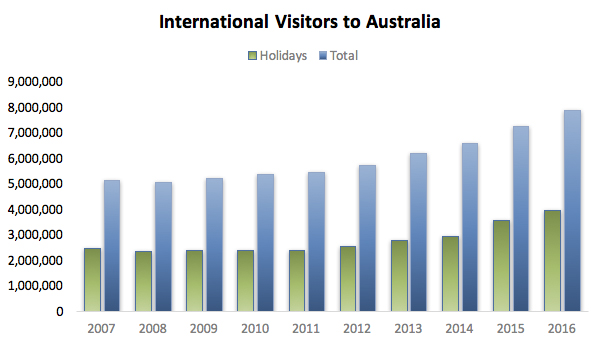The following article appeared on ASX.com.au on February 22, 2018.
Boom in international arrivals in Australia is good news for leisure-related companies.
Take it from an American who has settled in Sydney: Australia is a glorious place to live, work and play. Or, if my view isn’t quite enough or you haven’t already taken this on board, take it from the 7.9 million international travellers who visited Australia in the year to June 2017.
Australia’s prominence on the global travel scene is on the rise. Sure, a weakened Australian dollar helped, but the core drivers are the country’s natural beauty, strong economy and proximity to a rising Asian middle-class.
The trend is clear: the total number of international visitors to Australia has grown at a compound annualised rate of 4.3 per cent over the decade to June 2017, according to Tourism Research Australia. Better, though, is that interest in visiting Australia is strengthening: the same growth rate accelerated to 8.5 per cent over the past three years.
Even more powerful is the increase in holiday-goers, whose visits make up 50 per cent of total visitors today but have comprised 80.9 per cent of the increase in total visitors over the past three years.

Source: Austrade, Tourism Research Australia
The Australian economy at large is a beneficiary of this influx of visitors, although some industries are poised to benefit more than others. Think airlines (Qantas and Virgin Australia), hospitality (Mantra Group), gaming and entertainment (Crown Resorts), or tourism and transport (SeaLink Travel).
But investors should take care to appreciate that, just like putting a tuxedo on a pig doesn’t make it handsome, being a beneficiary of a long-term trend doesn’t necessarily make a stock a long-term winner.
Take Qantas. The flag-carrying Australian airline is a clear beneficiary of rising inbound tourism, but its share price still sits below previous highs in 1999 and 2007. Why? Rising demand does not change the fundamental nature of the industry with its low margins, intense price competition, vast capital requirements, powerful unions and exposure to volatile fuel prices.
Airport stocks attractive
Another clear beneficiary but with far less baggage, so to speak, is Sydney Airport, which is a direct beneficiary of greater passenger inbound passenger traffic thanks to increased demand for myriad airport services.
Sydney Airport has its own risks and challenges, namely that a second Sydney area airport would weaken its grip, but that headache is many years off and Sydney Airport will remain the go-to airport for business travellers and inbound tourists.
Speaking of airports, it’s worth remembering that a very similar business across the Tasman, Auckland International Airport, which many investors may not realise is listed on ASX, has similar competitive strengths and tailwinds on its home turf.
Higher growth alternatives
Higher growth options are also available to investors who are willing to zoom out and take a more global view. After all, Australia is not the only country in the world benefiting from increased travel: the global number of air transport passengers carried has grown at a 6 per cent annualised rate over the past decade, according to data compiled by The World Bank.
One such example is Gentrack. The Auckland-based company develops and markets billing and CRM software for energy utilities and water companies, as well as comprehensive operations systems for airports. Its software is mission critical and very difficult to strip out or replace. Indeed, the company’s prospectus in 2014 noted that its average customer tenure exceeded nine years.
Granted, the airports business only made up 13.3 per cent of earnings (EBITDA) in fiscal 2017, but the unit is growing solidly, has a sticky customer base, and the company has made two recent acquisitions to bolster its core airport offering.
The ongoing global trend towards increasing air travel also provides a consistent tailwind and no doubt contributes to why the company recently increased its long-term target of EBITDA growth to 15 per cent plus.
A Chinese focus
Another twist on the inbound tourism boom is to focus on China. The Chinese are taking to the skies at increasing rates. The World Bank notes that total Chinese air passengers have more than tripled over the past decade and many of those jetsetters are headed to Australia.
Chinese tourists are not just taking memories, photos and selfie sticks home with them: more than a few are taking some or even lots of Australian natural products as well. One specific name that springs to mind is Sukin, which is the flagship brand of Australia’s BWX.
Sukin sales increased 53.9 per cent in fiscal 2017, with much of that end-market demand pulling from China. It’s hard to say how much of the brand’s Australian sales are making their way back to China, but what is clear is that it is happening and the heightened brand awareness within China increases the odds of success for BWX’s own push into the country.
One theme, many destinations
The tourism boom is an opportunity and a reminder that not all potential winners from a significant trend are obvious beneficiaries. For that matter, the companies I have mentioned in this article have many facets to them and their own unique risks. Investors should take them purely as ideas for further research.
As far as a jumping off point for interesting ideas, though, it is clear that the broader theme is worth exploring.
Joe Magyer is the chief investment officer of Lakehouse Capital. The Lakehouse Small Companies Fund owns shares of Gentrack and BWX. This article contains general investment advice only (under AFSL 40069)
All of the commentary, statements of opinion and recommendations contain only general advice and have not taken into account your personal circumstances.
The responsible entity for the Lakehouse Small Companies Fund is One Managed Investment Funds Limited (ACN 117 400 987) (AFSL 297042) (“OMIFL”). The information contained in this document was not prepared by OMIFL but prepared by other parties. All of the commentary, statements of opinion and recommendations contain only general advice and have not taken into account your personal circumstances.
Any investment in Lakehouse or OMIFL products need to be made in accordance with and after reading the Product Disclosure Statement and Additional Product Disclosure Statement dated 15 November 2016. The opinions, advice, recommendations and other information contained in this report, whether express or implied, are published or made by Lakehouse in good faith in relation to the facts known at the time of preparation.
Limitation of liability: Whilst all care has been taken in preparation of this report, to the maximum extent permitted by law, neither Lakehouse or OMIFL will be liable in any way for any loss or damage suffered by you through use or reliance on this information. Lakehouse and OMIFL’s liability for negligence, breach of contract or contravention of any law, which cannot be lawfully excluded, is limited, at Lakehouse’s option and to the maximum extent permitted by law, to resupplying this information or any part of it to you, or to paying for the resupply of this information or any part of it to you.
Disclosure: Lakehouse, its directors, employees and affiliates, may, and likely do, hold units in the Lakehouse Small Companies Fund and securities in entities that are the subject of this report.





